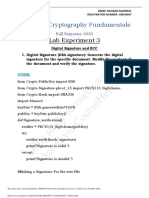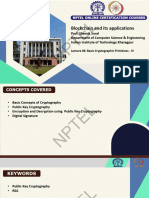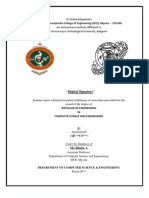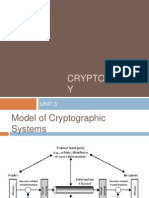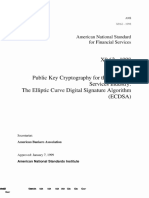Cryptography and Blockchain Security Lab Manual
Uploaded by
Jatin PatelCryptography and Blockchain Security Lab Manual
Uploaded by
Jatin PatelCentre of Distance and Online Education
Subject: Cryptography and Blockchain Security
Course: Diploma in Blockchain Technology
Year: 1ST Semester: 2nd
DUAL DEGREE PROGRAM
CRYPTOGRAPHY AND BLOCKCHAIN SECURITY
SEMESTER 2
DIPLOMA IN BLOCKCHAIN TECHNOLOGY
LAB MANUAL
pg. 1 Enrollment: 2422759060034
Centre of Distance and Online Education
Subject: Cryptography and Blockchain Security
Course: Diploma in Blockchain Technology
Year: 1ST Semester: 2nd
Certificate
This is to certify that
Mr. Jatin Patel
Enrolment Number 2422759060034 of Semester 01
has completed Lab Manual work of 10 Practical
for the subject - CRYPTOLOGY AND BLOCKCHAIN SECURITY
During the academic year 2024-25
Date of Submission:
Signature Signature Signature
(Student) (Subject Teacher) (Director)
pg. 2 Enrollment: 2422759060034
Centre of Distance and Online Education
Subject: Cryptography and Blockchain Security
Course: Diploma in Blockchain Technology
Year: 1ST Semester: 2nd
Practical Title
1. Encryption and Decryption using Symmetric Encryption
2. Digital Signature Verification using RSA or ECDSA
3. Blockchain Transaction Simulation
4. Hash Function Implementation (SHA-256 and MD5)
5. Smart Contract Development using Solidity and Remix IDE
6. Ethereum Wallet Creation and Management using MetaMask
7. Smart Contract Deployment on Local Blockchain using Ganache and Truffle
8. Blockchain-Based Voting System Simulation
9. Decentralized File Storage using IPFS
10. Cybersecurity Attack and Defense Simulation (Brute-force, MITM, etc.)
pg. 3 Enrollment: 2422759060034
Centre of Distance and Online Education
Subject: Cryptography and Blockchain Security
Course: Diploma in Blockchain Technology
Year: 1ST Semester: 2nd
Practical 1: Encryption and Decryption using Symmetric Encryption
Objective: Implement a program to encrypt and decrypt messages using symmetric encryption
algorithms like AES or DES.
Theory: Encryption converts plain text into unreadable cipher text using a key, and decryption
converts it back to the original form. Symmetric encryption uses the same key for both
encryption and decryption. AES (Advanced Encryption Standard) and DES (Data Encryption
Standard) are common symmetric algorithms. AES is more secure and widely used due to its
stronger key sizes (128, 192, or 256 bits).
Tools Required:
• Python 3.x
• pycryptodome or cryptography library
• Text editor or IDE
Procedure:
1. Install pycryptodome using pip: pip install pycryptodome
2. Write a program to encrypt and decrypt a message using AES.
Sample Code:
from Crypto.Cipher import AES
from Crypto.Random import
get_random_bytes import base64
def pad(text):
while len(text) % 16 != 0:
text += ' '
return text
pg. 4 Enrollment: 2422759060034
Centre of Distance and Online Education
Subject: Cryptography and Blockchain Security
Course: Diploma in Blockchain Technology
Year: 1ST Semester: 2nd
key = get_random_bytes(16)
cipher = AES.new(key, AES.MODE_CBC)
message = pad("This is a secret message.")
ciphertext = cipher.encrypt(message.encode('utf-8'))
print("Cipher Text:", base64.b64encode(ciphertext))
cipher_dec = AES.new(key, AES.MODE_CBC, cipher.iv)
decrypted = cipher_dec.decrypt(ciphertext).decode('utf-8').strip()
print("Decrypted Text:", decrypted)
Observations:
• The same key must be used for encryption and decryption.
• The output ciphertext changes with a different IV.
Result: The encryption and decryption of a message using AES was successfully implemented.
Conclusion: Symmetric encryption is fast and efficient for securing messages when the key is
securely shared.
Viva Questions:
1. What is symmetric encryption?
2. How is AES different from DES?
3. What is padding in encryption?
4. Why is IV important?
5. What are the limitations of symmetric encryption?
Practical 2: Digital Signature Verification using RSA or ECDSA
pg. 5 Enrollment: 2422759060034
Centre of Distance and Online Education
Subject: Cryptography and Blockchain Security
Course: Diploma in Blockchain Technology
Year: 1ST Semester: 2nd
Objective: Write a code to verify the authenticity and integrity of a digital signature using RSA
or ECDSA.
Theory: A digital signature ensures the integrity and authenticity of a message. RSA and ECDSA
are asymmetric cryptographic algorithms used for signing and verification. The private key is
used to sign, and the public key is used to verify.
Tools Required:
• Python 3.x
• cryptography or rsa library
Procedure:
1. Generate RSA keys.
2. Sign a message using the private key.
3. Verify the message using the public key.
Sample Code:
import rsa
# Key Generation
(pub_key, priv_key) = rsa.newkeys(512)
message = b"Verify this message"
pg. 6 Enrollment: 2422759060034
Centre of Distance and Online Education
Subject: Cryptography and Blockchain Security
Course: Diploma in Blockchain Technology
Year: 1ST Semester: 2nd
signature = rsa.sign(message, priv_key, 'SHA-256')
# Verification
try:
rsa.verify(message, signature, pub_key)
print("Signature is valid.")
except:
print("Signature is invalid.")
Observations:
• The signature is unique to the message and private key.
• A change in the message or key results in verification failure.
Result: Successfully verified a digital signature using RSA.
Conclusion: Digital signatures are crucial for ensuring data integrity and authenticity.
pg. 7 Enrollment: 2422759060034
Centre of Distance and Online Education
Subject: Cryptography and Blockchain Security
Course: Diploma in Blockchain Technology
Year: 1ST Semester: 2nd
Practical 2: Digital Signature Verification using Asymmetric Encryption
Objective:
To write a program to verify the authenticity and integrity of a digital signature using
asymmetric encryption algorithms like RSA or ECDSA.
Theory:
A digital signature is a mathematical scheme used to validate the authenticity and integrity of a
message, software, or digital document.
• Asymmetric Encryption uses a public key and a private key.
• The sender signs the message using their private key.
• The receiver verifies the message using the sender’s public
key. Popular Algorithms:
• RSA (Rivest-Shamir-Adleman) – widely used in secure data transmission.
• ECDSA (Elliptic Curve Digital Signature Algorithm) – faster and more efficient for
devices with limited computing power.
Key Benefits:
• Ensures authentication (message came from the claimed sender)
pg. 8 Enrollment: 2422759060034
Centre of Distance and Online Education
Subject: Cryptography and Blockchain Security
Course: Diploma in Blockchain Technology
Year: 1ST Semester: 2nd
• Maintains integrity (message has not been altered)
Tools Required:
• Python 3.x
• cryptography or pycryptodome library
• IDE or terminal
Procedure:
1. Generate RSA key pair.
2. Create a hash of the message.
3. Sign the hash using the private key.
4. Verify the signature using the public key.
Sample Code (Using RSA and cryptography):
python
CopyEdit
from cryptography.hazmat.primitives.asymmetric import rsa, padding
from cryptography.hazmat.primitives import hashes, serialization
from cryptography.hazmat.backends import default_backend
# 1. Generate RSA Key Pair
pg. 9 Enrollment: 2422759060034
Centre of Distance and Online Education
Subject: Cryptography and Blockchain Security
Course: Diploma in Blockchain Technology
Year: 1ST Semester: 2nd
private_key = rsa.generate_private_key(public_exponent=65537, key_size=2048)
public_key = private_key.public_key()
# 2. Message to be signed
message = b'Hello, this is a digitally signed message.'
# 3. Sign the message
signature = private_key.sign(
message,
padding.PSS(
mgf=padding.MGF1(hashes.SHA256()),
salt_length=padding.PSS.MAX_LENGTH
),
hashes.SHA256()
print("Signature generated.")
# 4. Verify the signature
try:
public_key.verify(
signature,
message,
pg. 10 Enrollment: 2422759060034
Centre of Distance and Online Education
Subject: Cryptography and Blockchain Security
Course: Diploma in Blockchain Technology
Year: 1ST Semester: 2nd
padding.PSS( mgf=padding.MGF1(hashes.S
HA256()),
salt_length=padding.PSS.MAX_LENGTH
),
hashes.SHA256()
print("Signature verified. The message is authentic.")
except:
print("Signature verification failed.")
Observations:
• A digital signature was created using the private key.
• The signature was successfully verified using the corresponding public key.
• Changing the message would cause the verification to fail.
Result:
Successfully implemented a digital signature verification program using RSA. The system
correctly authenticated and validated the integrity of the message.
Conclusion:
Digital signatures are essential in cybersecurity for verifying authenticity and preventing
tampering. RSA provides a reliable method for signing and verifying messages.
pg. 11 Enrollment: 2422759060034
Centre of Distance and Online Education
Subject: Cryptography and Blockchain Security
Course: Diploma in Blockchain Technology
Year: 1ST Semester: 2nd
Practical 3: Blockchain Transaction
Simulation Objective:
Develop a simple blockchain transaction simulation program that demonstrates the process of
creating and validating transactions in a blockchain network.
Theory:
A blockchain is a decentralized digital ledger that stores data across a distributed network of
computers. Each new entry (called a “block”) contains a set of transactions and is
cryptographically linked to the previous block, forming a chain.
In a simplified blockchain simulation:
• Transactions contain sender, receiver, and amount.
• Blocks contain a group of transactions, a timestamp, a hash, and a link to the
previous block’s hash.
pg. 12 Enrollment: 2422759060034
Centre of Distance and Online Education
Subject: Cryptography and Blockchain Security
Course: Diploma in Blockchain Technology
Year: 1ST Semester: 2nd
• Hashing secures the data and ensures immutability.
• Optional components like Proof-of-Work can be included to mimic real-world
block mining.
This simulation helps you understand the foundational structure of blockchain technology and
how it maintains data integrity and security.
Tools Required:
• Python 3.x
• IDE or text editor (e.g., PyCharm, VS Code)
• Standard Python libraries (hashlib, time)
Procedure:
1. Create a Transaction class that holds sender, receiver, and amount.
2. Create a Block class that includes index, timestamp, transaction list, previous hash,
and current hash.
3. Define a Blockchain class to manage the chain of blocks.
4. Add methods to create a genesis block and to add new blocks.
5. Display the blockchain contents.
Sample Code:
python
CopyEdit
pg. 13 Enrollment: 2422759060034
Centre of Distance and Online Education
Subject: Cryptography and Blockchain Security
Course: Diploma in Blockchain Technology
Year: 1ST Semester: 2nd
import hashlib
import time
class Transaction:
def init (self, sender, receiver, amount):
self.sender = sender
self.receiver = receiver
self.amount = amount
class Block:
def init (self, index, transactions, timestamp, previous_hash):
self.index = index
self.transactions = transactions
self.timestamp = timestamp
self.previous_hash = previous_hash
self.hash = self.calculate_hash()
def calculate_hash(self):
data = str(self.index) + str(self.timestamp) + str([vars(tx) for tx in self.transactions]) +
self.previous_hash
return hashlib.sha256(data.encode()).hexdigest()
class Blockchain:
def init (self):
self.chain = [self.create_genesis_block()]
pg. 14 Enrollment: 2422759060034
Centre of Distance and Online Education
Subject: Cryptography and Blockchain Security
Course: Diploma in Blockchain Technology
Year: 1ST Semester: 2nd
def create_genesis_block(self):
return Block(0, [], time.time(), "0")
def get_latest_block(self):
return self.chain[-1]
def add_block(self, transactions):
latest_block = self.get_latest_block()
new_block = Block(len(self.chain), transactions, time.time(), latest_block.hash)
self.chain.append(new_block)
# Simulate transactions and blocks
blockchain = Blockchain()
transactions = [Transaction("Alice", "Bob", 100), Transaction("Bob", "Charlie", 50)]
blockchain.add_block(transactions)
# Display the blockchain
for block in blockchain.chain:
print("Block Index:", block.index)
print("Timestamp:", block.timestamp)
print("Transactions:", [vars(tx) for tx in block.transactions])
print("Previous Hash:", block.previous_hash)
pg. 15 Enrollment: 2422759060034
Centre of Distance and Online Education
Subject: Cryptography and Blockchain Security
Course: Diploma in Blockchain Technology
Year: 1ST Semester: 2nd
print("Current Hash:",
block.hash) print("-" * 50)
Observations:
• Each block includes its own hash and the previous block’s hash, ensuring
tamper resistance.
• Changing any part of a transaction alters the block hash, breaking the chain.
• This simple blockchain doesn't use consensus algorithms like Proof-of-Work but
still demonstrates core concepts.
Result:
A basic blockchain simulation was successfully implemented. Transactions were securely
grouped into blocks, and each block was cryptographically linked to maintain data integrity.
Conclusion:
This practical provides a fundamental understanding of how blockchain secures data through
linked blocks and hashing. It serves as a foundational concept for more advanced topics like
consensus algorithms, smart contracts, and distributed networks.
pg. 16 Enrollment: 2422759060034
Centre of Distance and Online Education
Subject: Cryptography and Blockchain Security
Course: Diploma in Blockchain Technology
Year: 1ST Semester: 2nd
Practical 4: Hash Function Implementation
Objective:
Implement a cryptographic hash function such as SHA-256 or MD5 to generate hash values for
given inputs and demonstrate collision resistance.
Theory:
pg. 17 Enrollment: 2422759060034
Centre of Distance and Online Education
Subject: Cryptography and Blockchain Security
Course: Diploma in Blockchain Technology
Year: 1ST Semester: 2nd
A hash function is a mathematical function that converts an input (or “message”) into a fixed-
size string of bytes. The output is called a hash or digest. Cryptographic hash functions are
widely used in digital signatures, message integrity checks, and blockchain.
Key Properties of Cryptographic Hash Functions:
• Deterministic: Same input always produces the same hash.
• Fast computation: Hash is computed quickly.
• Pre-image resistance: Difficult to reverse a hash to find the original input.
• Collision resistance: No two inputs should produce the same hash.
• Avalanche effect: A small change in input drastically changes the output.
Common Algorithms:
• SHA-256: Secure Hash Algorithm 256-bit (used in Bitcoin, SSL, etc.)
• MD5: Message Digest 5 (faster but outdated and insecure for cryptographic use)
Tools Required:
• Python 3.x
• Standard libraries: hashlib
Procedure:
1. Write a Python program to take input from the user.
2. Apply both SHA-256 and MD5 to the input.
3. Display the resulting hash values.
pg. 18 Enrollment: 2422759060034
Centre of Distance and Online Education
Subject: Cryptography and Blockchain Security
Course: Diploma in Blockchain Technology
Year: 1ST Semester: 2nd
4. Modify the input slightly and observe the hash changes.
5. Discuss the significance of collision resistance.
Sample Code:
python
CopyEdit
import hashlib
def hash_input(input_text):
sha256_hash = hashlib.sha256(input_text.encode()).hexdigest()
md5_hash = hashlib.md5(input_text.encode()).hexdigest()
return sha256_hash, md5_hash
# User input
text = input("Enter a message to hash: ")
sha256_val, md5_val = hash_input(text)
print("\nOriginal Text:", text)
print("SHA-256 Hash :",
sha256_val) print("MD5 Hash
:", md5_val)
# Slight modification
modified_text = text + "!"
sha256_mod, md5_mod = hash_input(modified_text)
pg. 19 Enrollment: 2422759060034
Centre of Distance and Online Education
Subject: Cryptography and Blockchain Security
Course: Diploma in Blockchain Technology
Year: 1ST Semester: 2nd
print("\nModified Text:", modified_text)
print("SHA-256 Hash :", sha256_mod)
print("MD5 Hash :", md5_mod)
Observations:
• Even a minor change in input (like adding a punctuation mark) drastically changes
the hash.
• SHA-256 produces a 64-character hexadecimal hash.
• MD5 produces a 32-character hexadecimal hash.
• Hashes are irreversible—original messages cannot be retrieved from hash values.
Result:
The hash values were successfully generated using SHA-256 and MD5. It was observed that a
small change in input leads to completely different hash outputs, validating the avalanche effect
and collision resistance.
Conclusion:
Cryptographic hash functions like SHA-256 are essential for ensuring data integrity. They
provide a reliable mechanism to verify data without revealing the original content. Though MD5
is still used in some cases, it is vulnerable to collisions and should be avoided in security-critical
applications.
Practical 5: Smart Contract Development
pg. 20 Enrollment: 2422759060034
Centre of Distance and Online Education
Subject: Cryptography and Blockchain Security
Course: Diploma in Blockchain Technology
Year: 1ST Semester: 2nd
Objective:
To write, deploy, and test a basic smart contract using Solidity on the Ethereum blockchain
(test environment such as Remix IDE or Ganache).
Theory:
A smart contract is a self-executing program stored on a blockchain that automatically enforces
rules and executes actions when predefined conditions are met. These contracts eliminate the
need for intermediaries in transactions.
Key Features of Smart Contracts:
• Written in languages like Solidity (for Ethereum)
• Immutable once deployed on the blockchain
• Executed by the Ethereum Virtual Machine (EVM)
• Publicly accessible and verifiable
Popular Environments:
• Remix IDE: A web-based tool for writing, testing, and deploying Solidity contracts.
• Ganache: A local Ethereum blockchain for testing smart contracts.
• MetaMask: A browser extension for managing Ethereum wallets and interacting
with contracts.
Tools Required:
• Remix IDE (https://remix.ethereum.org/)
• Web3-compatible browser (Chrome with MetaMask)
• Internet connection
Procedure:
1. Open Remix IDE in your browser.
pg. 21 Enrollment: 2422759060034
Centre of Distance and Online Education
Subject: Cryptography and Blockchain Security
Course: Diploma in Blockchain Technology
Year: 1ST Semester: 2nd
2. Create a new Solidity file (e.g., SimpleContract.sol).
3. Write a basic smart contract to store and retrieve a number.
4. Compile the contract using the Solidity compiler.
5. Deploy the contract using the JavaScript VM environment in Remix.
6. Interact with the deployed contract via the Remix GUI.
Sample Code (Solidity – Version ^0.8.0):
solidity
CopyEdit
// SPDX-License-Identifier: MIT
pragma solidity ^0.8.0;
contract SimpleStorage
{ uint public
storedNumber;
function set(uint _num) public
{ storedNumber = _num;
function get() public view returns (uint)
{ return storedNumber;
pg. 22 Enrollment: 2422759060034
Centre of Distance and Online Education
Subject: Cryptography and Blockchain Security
Course: Diploma in Blockchain Technology
Year: 1ST Semester: 2nd
Steps in Remix IDE:
1. Click on the “Solidity Compiler” tab → Select version 0.8.x → Compile the contract.
2. Go to the “Deploy & Run Transactions” tab:
o Environment: JavaScript VM
o Click “Deploy”
3. After deployment, test the contract:
o Use the set() function to store a number.
o Use the get() function to retrieve the number.
Observations:
• The contract was compiled and deployed successfully using Remix IDE.
• The set() function correctly updated the stored value.
• The get() function returned the exact stored value.
• Each interaction created a transaction on the simulated Ethereum environment.
Result:
A simple smart contract was developed, deployed, and tested successfully. The contract
correctly stored and retrieved a numerical value.
Conclusion:
Smart contracts allow decentralized, automated interactions on a blockchain. This practical
introduced Solidity programming, contract deployment, and interaction using Remix IDE,
forming a foundation for more advanced decentralized applications (DApps).
pg. 23 Enrollment: 2422759060034
Centre of Distance and Online Education
Subject: Cryptography and Blockchain Security
Course: Diploma in Blockchain Technology
Year: 1ST Semester: 2nd
Practical 6: Ethereum Wallet Creation and Management
Objective:
To create and manage an Ethereum wallet using MetaMask, generate public/private key pairs,
and understand wallet functionalities.
Theory:
An Ethereum wallet is a digital tool that allows users to store and manage their Ethereum (ETH)
and interact with smart contracts on the Ethereum blockchain.
Types of Wallets:
• Hot Wallets: Connected to the internet (e.g., MetaMask, Trust Wallet)
• Cold Wallets: Offline wallets for added security (e.g., Ledger, Trezor)
MetaMask is a browser extension that functions as a crypto wallet and gateway to blockchain
apps (DApps). It allows users to:
• Generate Ethereum accounts
• Store private keys securely
• Send/receive ETH and tokens
• Interact with decentralized applications
Tools Required:
• Google Chrome or Firefox
• MetaMask browser extension
• Internet connection
pg. 24 Enrollment: 2422759060034
Centre of Distance and Online Education
Subject: Cryptography and Blockchain Security
Course: Diploma in Blockchain Technology
Year: 1ST Semester: 2nd
Procedure:
1. Install MetaMask:
o Visit https://metamask.io
o Download and install the extension for Chrome/Firefox
2. Create a New Wallet:
o Click "Get Started" → "Create a Wallet"
o Set a strong password
o Securely save the Secret Recovery Phrase (12 words)
3. View Wallet Details:
o View public address (starts with 0x...)
o Note that private key should never be shared
4. Switch to Test Networks:
o Enable test networks (e.g., Sepolia, Goerli) in settings
o Request test ETH from a faucet for experimentation
5. Send/Receive ETH:
o Use the “Send” button to transfer ETH
o Receive by copying the wallet address and sharing with sender
Observations:
• MetaMask securely generates and stores public/private key pairs.
• Wallets on test networks are useful for safe experimentation.
• The seed phrase is the only way to recover a lost wallet.
pg. 25 Enrollment: 2422759060034
Centre of Distance and Online Education
Subject: Cryptography and Blockchain Security
Course: Diploma in Blockchain Technology
Year: 1ST Semester: 2nd
Result:
An Ethereum wallet was successfully created and tested using MetaMask. ETH was sent and
received using public wallet addresses on a test network.
Conclusion:
MetaMask simplifies Ethereum wallet management, enabling secure storage, transaction
handling, and interaction with smart contracts and decentralized apps.
pg. 26 Enrollment: 2422759060034
Centre of Distance and Online Education
Subject: Cryptography and Blockchain Security
Course: Diploma in Blockchain Technology
Year: 1ST Semester: 2nd
Practical 7: Smart Contract Deployment on Local Blockchain using Ganache
Objective:
To deploy and test a smart contract on a local Ethereum blockchain using Ganache and Truffle
Suite.
Theory:
Ganache is a local Ethereum blockchain simulator used for developing, testing, and deploying
smart contracts. It provides:
• Pre-funded test accounts
• Instant transaction confirmation
• Insight into gas usage and contract logs
Truffle Suite is a development framework for Ethereum that helps compile, migrate, and test
smart contracts.
Tools Required:
• Node.js and npm
• Ganache (GUI or CLI)
• Truffle framework
• MetaMask (optional for integration)
pg. 27 Enrollment: 2422759060034
Centre of Distance and Online Education
Subject: Cryptography and Blockchain Security
Course: Diploma in Blockchain Technology
Year: 1ST Semester: 2nd
Procedure:
1. Install Node.js and Truffle:
bash
CopyEdit
npm install -g truffle
2. Install Ganache:
o Download from https://trufflesuite.com/ganache
o Launch the application and create a new workspace
3. Initialize Truffle Project:
bash
CopyEdit
mkdir local-blockchain-project
cd local-blockchain-project
truffle init
4. Create Smart Contract:
o Save a contract file in contracts/SimpleStorage.sol
solidity
CopyEdit
// SPDX-License-Identifier: MIT
pragma solidity ^0.8.0;
contract SimpleStorage
{ uint public data;
pg. 28 Enrollment: 2422759060034
Centre of Distance and Online Education
Subject: Cryptography and Blockchain Security
Course: Diploma in Blockchain Technology
Year: 1ST Semester: 2nd
function set(uint _val) public
{ data = _val;
function get() public view returns (uint)
{ return data;
5. Compile Contract:
bash
CopyEdit
truffle compile
6. Configure Ganache Network in truffle-config.js:
javascript
CopyEdit
module.exports = {
networks: {
development:
{ host:
"127.0.0.1",
port: 7545,
network_id: "*"
},
compilers: {
solc: {
pg. 29 Enrollment: 2422759060034
Centre of Distance and Online Education
Subject: Cryptography and Blockchain Security
Course: Diploma in Blockchain Technology
Year: 1ST Semester: 2nd
version: "0.8.0"
};
7. Write Migration File (migrations/2_deploy_contracts.js):
javascript
CopyEdit
const SimpleStorage = artifacts.require("SimpleStorage");
module.exports = function (deployer) {
deployer.deploy(SimpleStorage);
};
8. Run Ganache and Deploy Contract:
o Open Ganache → Note port 7545
bash
CopyEdit
truffle migrate --network development
9. Interact Using Truffle Console:
bash
CopyEdit
truffle console --network development
let instance = await SimpleStorage.deployed()
instance.set(42)
let value = await instance.get()
pg. 30 Enrollment: 2422759060034
Centre of Distance and Online Education
Subject: Cryptography and Blockchain Security
Course: Diploma in Blockchain Technology
Year: 1ST Semester: 2nd
console.log(value.toString())
Observations:
• Contract deployment on local network is fast and gas-free.
• Ganache shows transaction logs, block info, and account balances.
• Truffle simplifies compilation, migration, and testing workflows.
Result:
A smart contract was successfully deployed and tested on a local Ethereum blockchain using
Ganache and Truffle.
Conclusion:
Deploying on a local blockchain helps developers safely test and debug smart contracts before
deploying to live networks. This setup is ideal for rapid prototyping and DApp development.
pg. 31 Enrollment: 2422759060034
Centre of Distance and Online Education
Subject: Cryptography and Blockchain Security
Course: Diploma in Blockchain Technology
Year: 1ST Semester: 2nd
Practical 8: Blockchain-Based Voting System Simulation
Objective:
To simulate a secure and transparent voting system using blockchain technology and smart
contracts.
Theory:
Traditional voting systems are vulnerable to fraud, tampering, and lack transparency.
Blockchain-based voting systems solve these issues by offering:
• Decentralization – no central point of control
• Transparency – votes are visible on a public ledger
• Immutability – once recorded, votes cannot be changed
• Anonymity – voters' identities are hidden, but the vote is
counted A simple blockchain voting contract typically includes:
• A list of candidates
pg. 32 Enrollment: 2422759060034
Centre of Distance and Online Education
Subject: Cryptography and Blockchain Security
Course: Diploma in Blockchain Technology
Year: 1ST Semester: 2nd
• A voter registry
• Voting logic that restricts users to one vote
• Vote counting mechanism
Tools Required:
• Remix IDE (https://remix.ethereum.org/)
• MetaMask (optional, for real network interaction)
• Solidity
Procedure:
1. Open Remix IDE.
2. Create a new file: VotingSystem.sol.
3. Write a Solidity smart contract to manage candidates and voters.
4. Compile and deploy the contract using JavaScript VM.
5. Interact with the contract to cast votes and check results.
Sample Code (Solidity – Voting System):
solidity
CopyEdit
// SPDX-License-Identifier: MIT
pragma solidity ^0.8.0;
contract VotingSystem {
struct Candidate {
uint id;
pg. 33 Enrollment: 2422759060034
Centre of Distance and Online Education
Subject: Cryptography and Blockchain Security
Course: Diploma in Blockchain Technology
Year: 1ST Semester: 2nd
string name;
uint voteCount;
address public electionCommission;
mapping(address => bool) public hasVoted;
mapping(uint => Candidate) public candidates;
uint public candidatesCount;
constructor() {
electionCommission = msg.sender;
addCandidate("Alice");
addCandidate("Bob");
function addCandidate(string memory _name) public {
require(msg.sender == electionCommission, "Only EC can add candidates");
candidatesCount++;
candidates[candidatesCount] = Candidate(candidatesCount, _name, 0);
function vote(uint _candidateId) public { require(!
hasVoted[msg.sender], "Already voted");
require(_candidateId > 0 && _candidateId <= candidatesCount, "Invalid candidate");
pg. 34 Enrollment: 2422759060034
Centre of Distance and Online Education
Subject: Cryptography and Blockchain Security
Course: Diploma in Blockchain Technology
Year: 1ST Semester: 2nd
hasVoted[msg.sender] = true;
candidates[_candidateId].voteCount++;
function getVoteCount(uint _candidateId) public view returns (uint)
{ return candidates[_candidateId].voteCount;
Steps in Remix IDE:
1. Compile:
o Click the Solidity compiler tab
o Select version ^0.8.0
o Click “Compile VotingSystem.sol”
2. Deploy:
o Go to “Deploy & Run Transactions”
o Select Environment: JavaScript VM
o Click “Deploy”
3. Test the Contract:
o Call vote(1) from one account (vote for Alice)
o Call vote(2) from another account (vote for Bob)
o Try vote() again from same account – it should fail
o Use getVoteCount(1) and getVoteCount(2) to view vote counts
Observations:
pg. 35 Enrollment: 2422759060034
Centre of Distance and Online Education
Subject: Cryptography and Blockchain Security
Course: Diploma in Blockchain Technology
Year: 1ST Semester: 2nd
• Voters were able to vote only once.
• Vote counts were updated correctly.
• Any duplicate voting attempt was rejected by the contract.
• Candidates could only be added by the election commission (contract deployer).
Result:
Successfully simulated a blockchain-based voting system that ensured only one vote per
address, transparent vote counts, and immutable voting records.
Conclusion:
Blockchain-based voting systems can significantly enhance the integrity, transparency, and
security of elections. This simulation demonstrates the core functionalities needed for such
systems using smart contracts.
Practical 9: Decentralized File Storage using IPFS
Objective:
To upload and retrieve files using IPFS (InterPlanetary File System), a decentralized protocol
for peer-to-peer file storage and sharing.
Theory:
IPFS is a distributed file system that allows users to store and access content using
content- addressing (via cryptographic hashes), instead of traditional location-based
addressing (like URLs).
pg. 36 Enrollment: 2422759060034
Centre of Distance and Online Education
Subject: Cryptography and Blockchain Security
Course: Diploma in Blockchain Technology
Year: 1ST Semester: 2nd
Key Characteristics of IPFS:
• Content-addressed: Files are retrieved by their hash (CID), not their location
• Decentralized: Files are stored across multiple nodes
• Immutable: Content cannot be changed without changing the hash
• Efficient: Eliminates duplication and supports distributed caching
IPFS Use Cases:
• Decentralized web hosting
• NFT metadata storage
• Blockchain-based dApps needing off-chain file storage
Tools Required:
• IPFS Desktop or Command Line (https://docs.ipfs.io)
• Optional: Web3.Storage or Pinata for pinning
• Internet connection
Procedure:
Option 1: Using IPFS Desktop
1. Download and install IPFS Desktop from https://docs.ipfs.io/install.
2. Launch the app and open the local IPFS node dashboard.
3. Drag and drop a file into the web interface to upload it.
4. Note the Content Identifier (CID) generated for the file.
5. Use the CID in a browser to retrieve the
file: arduino
CopyEdit
https://ipfs.io/ipfs/<your-cid>
pg. 37 Enrollment: 2422759060034
Centre of Distance and Online Education
Subject: Cryptography and Blockchain Security
Course: Diploma in Blockchain Technology
Year: 1ST Semester: 2nd
Option 2: Using Command Line
1. Install IPFS
CLI: bash
CopyEdit
npm install -g ipfs
ipfs init
ipfs daemon
2. Add a file:
bash
CopyEdit
echo "Hello from IPFS!" > sample.txt
ipfs add sample.txt
3. Note the CID and open:
arduino
CopyEdit
https://ipfs.io/ipfs/<CID>
Observations:
• Each uploaded file receives a unique hash (CID).
• Accessing the CID retrieves the exact original content.
• Changing the file changes its CID completely.
• Files stored on IPFS are not automatically permanent unless “pinned”.
pg. 38 Enrollment: 2422759060034
Centre of Distance and Online Education
Subject: Cryptography and Blockchain Security
Course: Diploma in Blockchain Technology
Year: 1ST Semester: 2nd
Result:
Files were successfully uploaded to IPFS, assigned content hashes, and retrieved using public
gateways.
Conclusion:
IPFS offers a powerful and decentralized method of storing and sharing files that complements
blockchain technology by handling large or off-chain data efficiently.
Practical 9: Decentralized File Storage using IPFS
Objective:
To upload and retrieve files using IPFS (InterPlanetary File System), a decentralized protocol
for peer-to-peer file storage and sharing.
pg. 39 Enrollment: 2422759060034
Centre of Distance and Online Education
Subject: Cryptography and Blockchain Security
Course: Diploma in Blockchain Technology
Year: 1ST Semester: 2nd
Theory:
IPFS is a distributed file system that allows users to store and access content using
content- addressing (via cryptographic hashes), instead of traditional location-based
addressing (like URLs).
Key Characteristics of IPFS:
• Content-addressed: Files are retrieved by their hash (CID), not their location
• Decentralized: Files are stored across multiple nodes
• Immutable: Content cannot be changed without changing the hash
• Efficient: Eliminates duplication and supports distributed caching
IPFS Use Cases:
• Decentralized web hosting
• NFT metadata storage
• Blockchain-based dApps needing off-chain file storage
Tools Required:
• IPFS Desktop or Command Line (https://docs.ipfs.io)
• Optional: Web3.Storage or Pinata for pinning
• Internet connection
Procedure:
Option 1: Using IPFS Desktop
1. Download and install IPFS Desktop from https://docs.ipfs.io/install.
2. Launch the app and open the local IPFS node dashboard.
3. Drag and drop a file into the web interface to upload it.
4. Note the Content Identifier (CID) generated for the file.
pg. 40 Enrollment: 2422759060034
Centre of Distance and Online Education
Subject: Cryptography and Blockchain Security
Course: Diploma in Blockchain Technology
Year: 1ST Semester: 2nd
5. Use the CID in a browser to retrieve the
file: arduino
CopyEdit
https://ipfs.io/ipfs/<your-cid>
Option 2: Using Command Line
1. Install IPFS
CLI: bash
CopyEdit
npm install -g ipfs
ipfs init
ipfs daemon
2. Add a file:
bash
CopyEdit
echo "Hello from IPFS!" > sample.txt
ipfs add sample.txt
3. Note the CID and open:
arduino
CopyEdit
https://ipfs.io/ipfs/<CID>
Observations:
• Each uploaded file receives a unique hash (CID).
• Accessing the CID retrieves the exact original content.
• Changing the file changes its CID completely.
pg. 41 Enrollment: 2422759060034
Centre of Distance and Online Education
Subject: Cryptography and Blockchain Security
Course: Diploma in Blockchain Technology
Year: 1ST Semester: 2nd
• Files stored on IPFS are not automatically permanent unless “pinned”.
Result:
Files were successfully uploaded to IPFS, assigned content hashes, and retrieved using public
gateways.
Conclusion:
IPFS offers a powerful and decentralized method of storing and sharing files that complements
blockchain technology by handling large or off-chain data efficiently.
Practical 10: Cybersecurity Attack and Defense Simulation
Objective:
To simulate a basic cyber attack (e.g., brute-force login attempt or MITM attack) and
demonstrate mitigation techniques or defensive measures.
Theory:
Cybersecurity simulations help students understand:
• How attacks exploit vulnerabilities
• How to protect systems and networks
• Hands-on ethical hacking principles
Common Attack Vectors:
• Brute Force Attack: Repeatedly guessing passwords until successful
• Man-in-the-Middle (MITM): Intercepting communication between two parties
• SQL Injection: Injecting malicious SQL queries via user inputs
Defense Mechanisms:
• Rate-limiting, CAPTCHA
pg. 42 Enrollment: 2422759060034
Centre of Distance and Online Education
Subject: Cryptography and Blockchain Security
Course: Diploma in Blockchain Technology
Year: 1ST Semester: 2nd
• Encryption (TLS/SSL)
• Input sanitization
• Two-factor authentication
⚠ Always perform security testing in a legal and ethical environment, such as virtual labs or
sandboxed test environments.
Tools Required:
• Python 3.x
• Virtual machine (e.g., Kali Linux)
• Wireshark or Burp Suite (for network monitoring)
• Flask (for simple web app)
• Optional: DVWA or Metasploitable for advanced testing
Procedure:
Simulating a Brute-Force Attack (Basic)
1. Create a login form using Flask:
python
CopyEdit
from flask import Flask, request
app = Flask( name )
USERNAME = "admin"
PASSWORD = "password123"
@app.route('/login', methods=['POST'])
pg. 43 Enrollment: 2422759060034
Centre of Distance and Online Education
Subject: Cryptography and Blockchain Security
Course: Diploma in Blockchain Technology
Year: 1ST Semester: 2nd
def login():
if request.form['username'] == USERNAME and request.form['password'] == PASSWORD:
return "Login Successful"
return "Invalid Credentials"
app.run(debug=True)
2. Run the server:
bash
CopyEdit
python app.py
3. Create a brute-force attack script:
python
CopyEdit
import requests
url = 'http://localhost:5000/login'
usernames = ['admin']
passwords = ['123', 'admin', 'password', 'password123']
for pwd in passwords:
response = requests.post(url, data={'username': 'admin', 'password': pwd})
print(f"Trying password: {pwd} -> {response.text}")
Defensive Measure:
• Add CAPTCHA to the login form
• Lock account after multiple failed attempts
pg. 44 Enrollment: 2422759060034
Centre of Distance and Online Education
Subject: Cryptography and Blockchain Security
Course: Diploma in Blockchain Technology
Year: 1ST Semester: 2nd
• Monitor suspicious IP activity
Observations:
• The attacker script could guess weak passwords within seconds.
• Using strong passwords and implementing account lockout can stop brute-
force attempts.
• Monitoring tools like Wireshark can detect unauthorized requests.
Result:
A brute-force login attack was simulated, and defensive countermeasures such as input
restrictions and authentication rate-limiting were discussed.
Conclusion:
Understanding basic cyber attacks and implementing defense strategies is critical in securing
applications. Ethical simulations like this provide valuable insights into real-world cybersecurity
practices.
pg. 45 Enrollment: 2422759060034
You might also like
- This Study Resource Was: CSE 1011:cryptography FundamentalsNo ratings yetThis Study Resource Was: CSE 1011:cryptography Fundamentals6 pages
- Exp2 Write A Program To Implement RSA Algorithm and Digital Signature Scheme Using RSA ElGamalNo ratings yetExp2 Write A Program To Implement RSA Algorithm and Digital Signature Scheme Using RSA ElGamal6 pages
- Terna Engineering College: Class: TE Sem.: VINo ratings yetTerna Engineering College: Class: TE Sem.: VI6 pages
- RSA Algorithm - Secure Your Data With Public-Key EncryptionNo ratings yetRSA Algorithm - Secure Your Data With Public-Key Encryption11 pages
- Foet - de - Info - Sem 6 - 03 Lab Manual - 11360603 - Web and Network Security-1No ratings yetFoet - de - Info - Sem 6 - 03 Lab Manual - 11360603 - Web and Network Security-134 pages
- Experiment No-9: Name: Rhugved Satardekar Roll No: 17141208No ratings yetExperiment No-9: Name: Rhugved Satardekar Roll No: 171412088 pages
- Information Security Notes On Last Three-UnitesNo ratings yetInformation Security Notes On Last Three-Unites12 pages
- Public Key Algorithm, Digital SignatureNo ratings yetPublic Key Algorithm, Digital Signature11 pages
- Digital Signature (Application of Image Processing)No ratings yetDigital Signature (Application of Image Processing)7 pages
- 17-Digital Signatures, Digital Signature Standard (DSS) - 12!03!2024No ratings yet17-Digital Signatures, Digital Signature Standard (DSS) - 12!03!202418 pages
- Blockchain Practicals Reference JournalNo ratings yetBlockchain Practicals Reference Journal171 pages
- 4-20322ICO-OPE-04711-EN-V10 PCI PTS Security Policy Move 2500-1647636305.95502No ratings yet4-20322ICO-OPE-04711-EN-V10 PCI PTS Security Policy Move 2500-1647636305.9550218 pages
- Bitcoin A Game Theoretic Analysis - Micah WarrenNo ratings yetBitcoin A Game Theoretic Analysis - Micah Warren344 pages
- The Elliptic Curve Digital Signature Algorithm PDFNo ratings yetThe Elliptic Curve Digital Signature Algorithm PDF128 pages
- Ansi x962 1998 The Elliptic Curve Digital Signature Algorithm Ecdsa - CompressNo ratings yetAnsi x962 1998 The Elliptic Curve Digital Signature Algorithm Ecdsa - Compress194 pages
- A Survey On Blockchain and Artificial Intelligence Technologies For Enhancing Security and Privacy in Smart EnvironmentsNo ratings yetA Survey On Blockchain and Artificial Intelligence Technologies For Enhancing Security and Privacy in Smart Environments19 pages
- Unit-1 Introduction To BlockChain TechnologyNo ratings yetUnit-1 Introduction To BlockChain Technology105 pages
- Slides 119 CFRG Hedged Ecdsa and Eddsa Signatures 00No ratings yetSlides 119 CFRG Hedged Ecdsa and Eddsa Signatures 007 pages
- The Preservation of Digital Signatures On The BlockchainNo ratings yetThe Preservation of Digital Signatures On The Blockchain17 pages
- Um2262 Getting Started With The Xcubesbsfu Stm32cube Expansion Package StmicroelectronicsNo ratings yetUm2262 Getting Started With The Xcubesbsfu Stm32cube Expansion Package Stmicroelectronics109 pages
- Algebraic Informatics 8th International Conference Cai 2019 Ni Serbia June 30july 4 2019 Proceedings 1st Ed Miroslav Iri DownloadNo ratings yetAlgebraic Informatics 8th International Conference Cai 2019 Ni Serbia June 30july 4 2019 Proceedings 1st Ed Miroslav Iri Download86 pages
- MobaXterm 172.20.38.104 20240924 HTTPS Activation Part1No ratings yetMobaXterm 172.20.38.104 20240924 HTTPS Activation Part19 pages
- Flaws in Applying Proof Methodologies To SignatureNo ratings yetFlaws in Applying Proof Methodologies To Signature19 pages
- Decentralized Privacy Preserving ReputationsystemNo ratings yetDecentralized Privacy Preserving Reputationsystem9 pages










